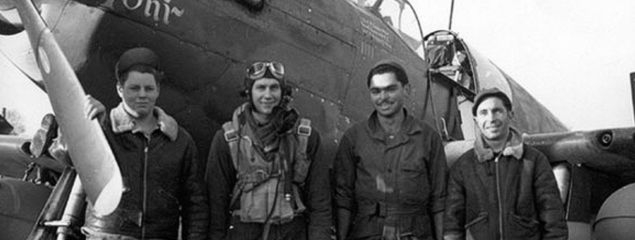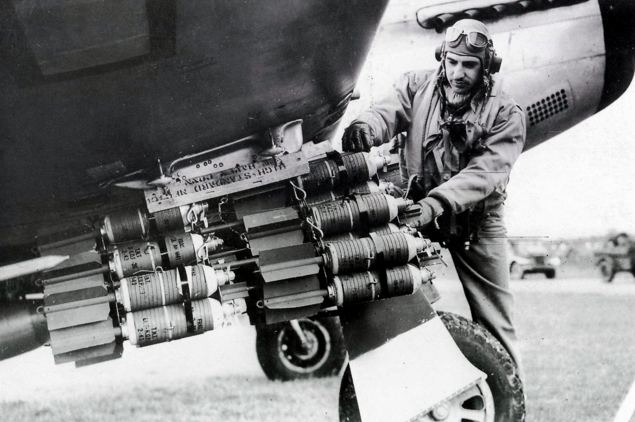D-Day
By 1st Lt. Donald F. Snow
By the end of February "Uncle" George Bickell's "Bulldogs" had gained confidence in combat experience. Some of our friends had not returned from the long missions into Germany. March first marked another tragedy which clouded our spirits. Lt. Gumm first ace of our Group was killed at the little Village of Nayland, not far from our field. He experienced engine trouble while on a training flight. While avoiding crashing into the town, his aircraft struck a tree, was thrown out of control and destroyed.
The first super-long distance escort missions to Berlin, five and more hours at a stretch, were very tiring for our pilots. They soon toughened to the long grinds, however, and managed to keep their nightly dates in Colchester at the "Red Lion" and the "George."

Lt. Charles F. Gumm, Jr. with his ground crew (L to R) Crew Chief S/Sgt Leonard, Pilot Lt. Gumm, Assistant Crew Chief Sgt. Seager and Armorer Sgt. Lippoff.
On April 10th, Captain "Bob" Stephens was elected to be our new Commanding Officer. Lt. Col. George Bickell was promoted to Assistant Group Commander. We were preparing for a move to Southern England, to an advanced landing strip. The invasion of France was imminent and, as we were the most experienced Fighter Group in the Ninth Air Force, the Tactical Air Force we were sure to be given an important part in supporting the invasion. The lull before the storm . . . spent at Lashenden Advanced Landing Strip near Headcorn, Kent was enjoyable in most respects. Of course there were times when we were restricted to the post but we had plenty of work to do and clubs and sports to keep our minds occupied. When we did get off the base, Maidstone and the surrounding villages afforded much social material.
The "storm" broke on the night of June 5th. The "gen" on the invasion of France . . . our part in the landings was given to us in a briefing. Our pilots took off that night and escorted the first C-47's and their gliders to the Utah beach section of the proposed landings. After the ice was broken our pilots were flying very long hours, the maintenance crews were right in there pitching every minute. We were carrying bombs to hit marshaling yards, bridges, convoys destroying the enemy's supply lines.
"Joe" Powers took off first at 1845 and destroyed 2 and 1/2 buzz-bombs before landing at 2330, dusk (one of his victories was destroyed over the field creating quite a thrill for the men, making them dash for their fox-holes).
Our advance party had left for France and were to land on Omaha Beach on June 17th. The night before our first landings a strange phenomenon occurred back at Lashenden, our rear echelon was startled and amazed by the appearance of the V-1 flying bomb. Ack-ack crews went berserk (trying to knock down the strange weapons) seriously menacing the "health" of the Base in their wild firings. Then, too, the bombs came over our area, headed for London, on all too numerous "trolley lines". Three of our pilots went up to chase them one night. "Joe" Powers took off first at 1845 and destroyed 2 and 1/2 buzz-bombs before landing at 2330, dusk (one of his victories was destroyed over the field creating quite a thrill for the men, making them dash for their fox-holes).
Operations in France
The 355th Squadron area was all setup for operations at A-2, near Cricqueville, Normandy, long before the rear echelon arrived. The boys really sweated to arrange dispersal and living areas for efficient operation. What a terrific inspiration we had now! Everyone felt part of the machine, a cog in the machinery of the largest and strongest invasion force the world has ever seen. The esprit de corps of the "Pugnacious Pups" was at its very highest ebb, at A-2, morale problems were completely absent. Our pilots were flying constantly . . . taking advantage of the excellent weather to smash all German communications that appeared in their gunsight. Some really terrific aerial combat with Jerry aircraft occurred at frequent intervals. Much of the flying at A-2 was patrol work, however.

A 355th pilot makes sure his load of anti-personnel fragmention bombs is secured on its wing rack just prior the mission to attack ground targets in France. (National Archives)
We left the "dust-bowl" in Normandy, three weeks after the breakthrough at St. Lo, to set up camp at Gael Airdrome, a rather beat-up Jerry base, on Brittany. Brittany's welcome was the warmest our Squadron would experience in all its traveling. There was good food to be had in Brittany, and beautiful girls to "promenade" with soldiers on Sundays. The "Bulldog" Squadron had the best location for camp at A-31. Weather was still ideal for camper outers. We were close to our fight line, on rather high ground.
Flights off A-31 took our pilots to the outskirts of Paris to support General Patton's Third Army in its drive on Paris. Brest was a hard nut to crack many strafing missions and dive-bombing missions were aimed at weakening resistance of the strongly held French port.
The 355th Squadron made history on the 25th of August. In two terrific aerial battles, 25 of our aircraft destroyed as many Jerry planes to set a theater record for in-the-air kills for one squadron in one day. Major Stephens and Capt. Emerson each led Squadron formations as the Jerries apparently browned-off at Patton's success in breaking through the Paris defenses sent up huge gaggles of FW-190's and Me-109's. Capt. Emerson, Lt. King and Lt. Foye each claimed three Krauts destroyed in-the-air; Capt. Long accounted for 2 and 1/2 enemy fighters; Major Stephens, destroyed two and Lt. Davis one and 1/2 Jerry planes.
On the 15th of September we moved from A-31 to an airstrip called A-66, on the bank of the Marne River, near St. Dizier. Our Squadron erected its tents among long rows of poplar trees between meadows in which cows and sheep grazed. Being close to the river, our men took advantage of the cool waters of the Marne swimming was popular. Before long, weather soured up missions became infrequent. Our new C/O, Major Maurice G. Long started a few building projects to keep the men occupied, time was hanging a bit heavily, and this lack of activity was somewhat of a let down.
